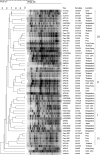Serogroup, virulence, and genetic traits of Vibrio parahaemolyticus in the estuarine ecosystem of Bangladesh
- PMID: 19684167
- PMCID: PMC2753069
- DOI: 10.1128/AEM.00266-09
Serogroup, virulence, and genetic traits of Vibrio parahaemolyticus in the estuarine ecosystem of Bangladesh
Abstract
Forty-two strains of Vibrio parahaemolyticus were isolated from Bay of Bengal estuaries and, with two clinical strains, analyzed for virulence, phenotypic, and molecular traits. Serological analysis indicated O8, O3, O1, and K21 to be the major O and K serogroups, respectively, and O8:K21, O1:KUT, and O3:KUT to be predominant. The K antigen(s) was untypeable, and pandemic serogroup O3:K6 was not detected. The presence of genes toxR and tlh were confirmed by PCR in all but two strains, which also lacked toxR. A total of 18 (41%) strains possessed the virulence gene encoding thermostable direct hemolysin (TDH), and one had the TDH-related hemolysin (trh) gene, but not tdh. Ten (23%) strains exhibited Kanagawa phenomenon that surrogates virulence, of which six, including the two clinical strains, possessed tdh. Of the 18 tdh-positive strains, 17 (94%), including the two clinical strains, had the seromarker O8:K21, one was O9:KUT, and the single trh-positive strain was O1:KUT. None had the group-specific or ORF8 pandemic marker gene. DNA fingerprinting employing pulsed-field gel electrophoresis (PFGE) of SfiI-digested DNA and cluster analysis showed divergence among the strains. Dendrograms constructed using PFGE (SfiI) images from a soft database, including those of pandemic and nonpandemic strains of diverse geographic origin, however, showed that local strains formed a cluster, i.e., "clonal cluster," as did pandemic strains of diverse origin. The demonstrated prevalence of tdh-positive and diarrheagenic serogroup O8:K21 strains in coastal villages of Bangladesh indicates a significant human health risk for inhabitants.
Figures


References
-
- Alam, M., N. A. Hasan, A. Sadique, N. A. Bhuiyan, K. U. Ahmed, S. Nusrin, G. B. Nair, A. K. Siddique, R. B. Sack, D. A. Sack, A. Huq, and R. R. Colwell. 2006. Seasonal cholera caused by Vibrio cholerae serogroups O1 and O139 in the coastal aquatic environment of Bangladesh. Appl. Environ. Microbiol. 72:4096-4104. - PMC - PubMed
-
- Alam, M. J., K. Tomochika, S. Miyoshi, and S. Shinoda. 2002. Environmental investigation of potentially pathogenic Vibrio parahaemolyticus in the Seto-Inland Sea, Japan. FEMS Microbiol. Lett. 208:83-87. - PubMed
-
- Ansaruzzaman, M., M. Lucas, J. L. Deen, N. A. Bhuiyan, X. Y. Wang, A. Safa, M. Sultana, A. Chowdhury, G. B. Nair, D. A. Sack, L. von Seidlein, M. K. Puri, M. Ali, C. L. Chaignat, J. D. Clemens, and A. Barreto. 2005. Pandemic serovars (O3:K6 and O4:K68) of Vibrio parahaemolyticus associated with diarrhea in Mozambique: spread of the pandemic into the African continent. J. Clin. Microbiol. 43:2559-2562. - PMC - PubMed
-
- APHA. 1970. Procedures for the bacteriological examination of sea water and shellfish. American Public Health Association, Washington, DC.
-
- Bag, P. K., S. Nandi, R. K. Bhadra, T. Ramamurthy, S. K. Bhattacharya, M. Nishibuchi, T. Hamabata, S. Yamasaki, Y. Takeda, and G. B. Nair. 1999. Clonal diversity among recently emerged strains of Vibrio parahaemolyticus O3:K6 associated with pandemic spread. J. Clin. Microbiol. 37:2354-2357. - PMC - PubMed
Publication types
MeSH terms
Substances
Grants and funding
LinkOut - more resources
Full Text Sources

